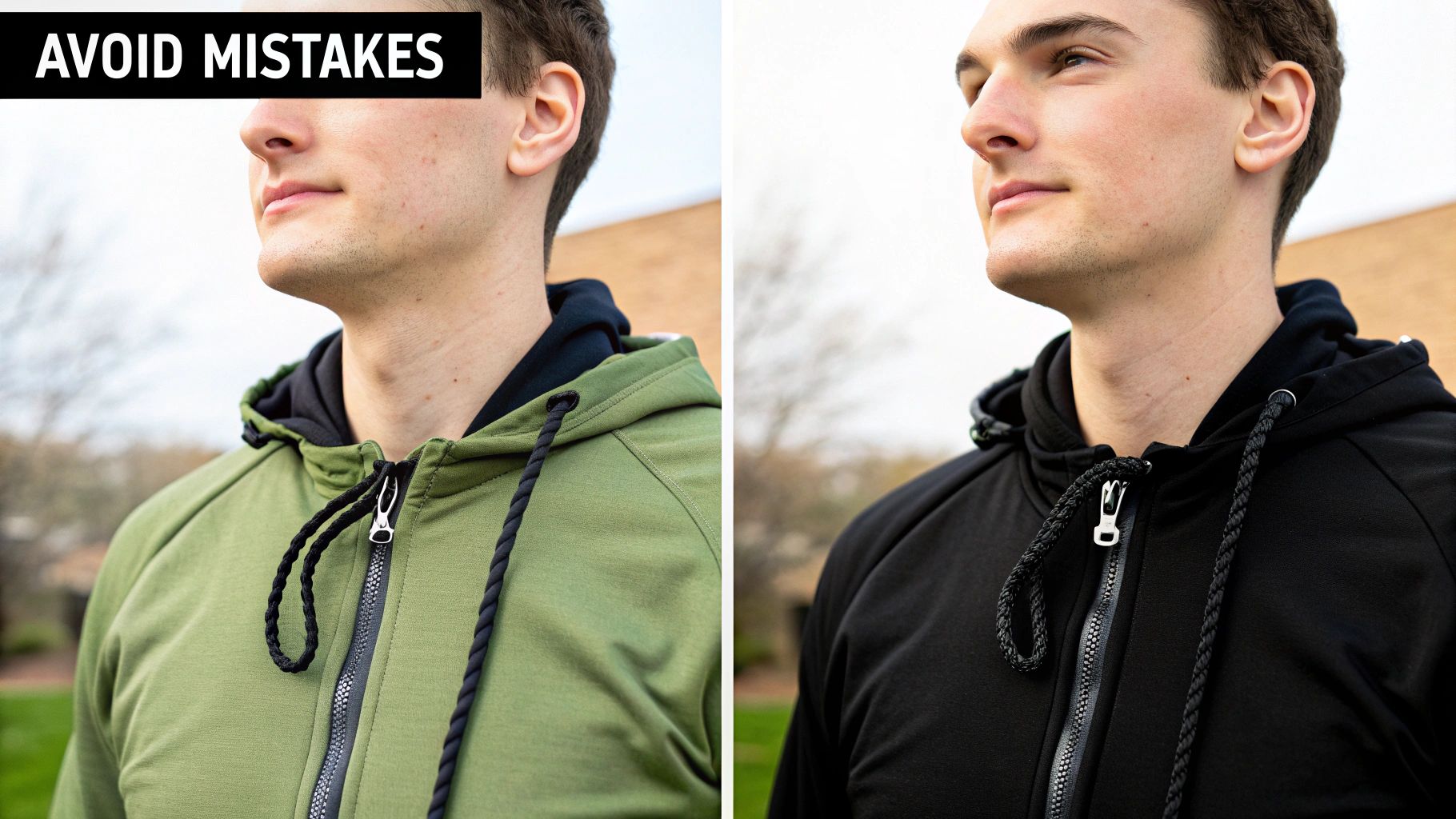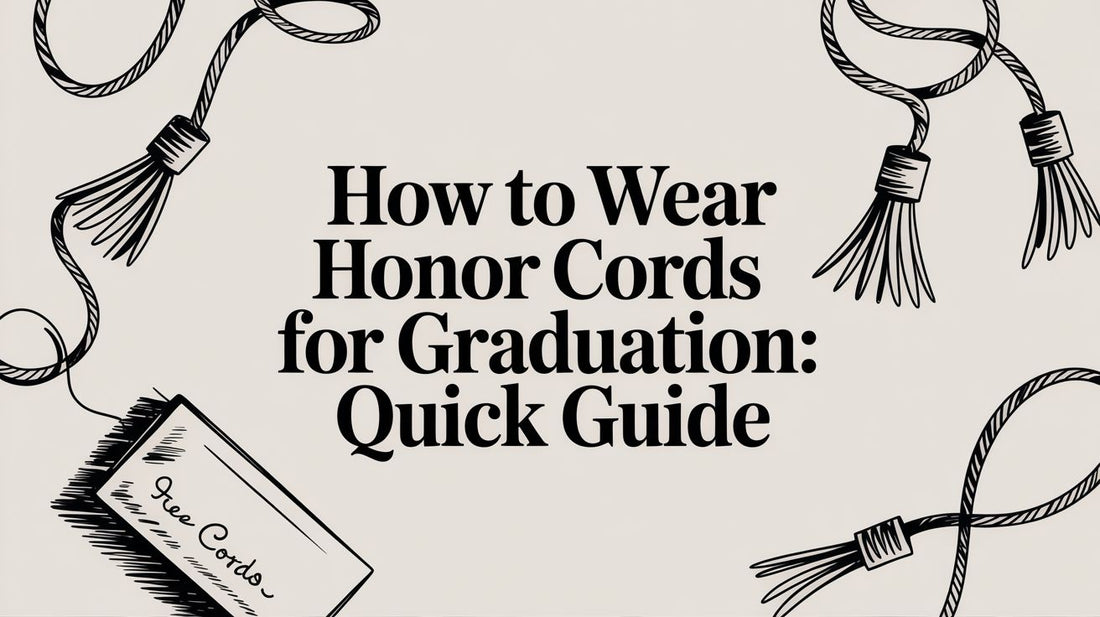To wear an honor cord, you'll start by finding the center—usually marked by a knot. Just drape that knot around the back of your neck. The two tassels should fall evenly down the front of your graduation gown.
The cords should rest neatly on your collarbones, sitting right between your gown's zipper and the edges of your academic stole. This placement is key for a clean, symmetrical look that lets your achievements shine without looking messy.
The Right Way to Wear Your Honor Cords
Your honor cords are way more than just another piece of your graduation outfit; they’re a proud symbol of all the hard work and dedication you poured into your studies. Wearing them correctly shows respect for academic tradition and, just as importantly, helps you look sharp and confident on your big day. The basic method of draping them is simple, but knowing the small details makes a big difference.

Understanding the Protocol
The rules for wearing honor cords are usually set by your university, but they're also guided by the standards of the honor societies that award them. It’s becoming more and more common to see them—in U.S. colleges, it’s estimated that 30-40% of graduates now wear cords, which shows a real shift toward celebrating academic excellence.
Unlike stoles or sashes, cords are always worn around the neck with the tassels hanging evenly on each side. The goal is to create a distinguished appearance that highlights your accomplishments without cluttering up your regalia.
Before the ceremony kicks off, it’s a good idea to find a mirror and give everything a final check. Make sure your cords lie flat against your gown and aren't twisted up with any jewelry or other accessories.
A well-worn honor cord should complement your entire academic ensemble. It’s meant to draw attention to your achievements, not distract from your overall look.
Honor Cord Etiquette At a Glance
Getting the little details right is what makes your graduation look feel complete. To make it simple, here’s a quick rundown of the essential dos and don'ts for wearing your honor cords with pride.
| Do | Don't |
|---|---|
| Drape the cord with the center knot at the back of your neck. | Wear the cord under your gown's collar or hood. |
| Allow the tassels to hang evenly down the front of your gown. | Let the cords get twisted with stoles, sashes, or jewelry. |
| Position the cords between your stole and your gown's zipper. | Pin the cords to your gown unless absolutely necessary. |
| Check for symmetry and ensure they lie flat. | Allow one side to hang noticeably lower than the other. |
Following these simple guidelines ensures your cords look just as impressive as the achievements they represent.
If you’re still putting together your graduation day look, you can purchase high-quality graduation honor cords to complete your regalia. A properly worn cord is the perfect final touch to celebrate years of hard work, making it a detail worth getting right. For more insights into graduation traditions, check out the resources at Trident University.
Understanding the Meaning Behind Cord Colors
Each honor cord you drape over your shoulders tells a part of your academic story. Those vibrant colors aren't just for show; they're a visual language that represents specific achievements, your field of study, or membership in a prestigious society. Knowing what they mean turns your regalia from a simple garment into a proud display of everything you've accomplished.
The most common color you'll see is gold. It's the universal signifier for the highest academic honors—think Summa Cum Laude, Magna Cum Laude, and Cum Laude. But the spectrum of colors goes far beyond general academic excellence, with each shade carrying its own unique tradition and meaning.
Decoding Common Academic Colors
While the exact color associations can sometimes vary a little between schools, there are widely accepted standards for many fields of study. This system helps create a visually consistent and meaningful experience at graduation ceremonies all across the country.
Here are a few common examples you’ll likely spot:
- Light Blue: Represents the field of Education, worn by our future teachers and administrators.
- Green: Often signifies achievements in Medicine or Environmental Studies.
- Lilac: Is traditionally associated with degrees in the Humanities and Arts.
- Orange: Typically worn by graduates from the demanding field of Engineering.
This color-coding tradition has deep historical roots, tracing back to the regalia of medieval European universities. Back then, specific colors and adornments showed a scholar's rank and area of expertise. We continue that tradition today, with most U.S. institutions awarding cords for high GPAs—often requiring a cumulative GPA somewhere between 3.4 and 3.9.
When you know what each color means, you're not just wearing a rope; you're carrying a piece of academic history that connects you to generations of scholars who came before you.
For a deeper dive into specific hues, you can check out our complete guide on honor cord color meanings to make sure your regalia is both accurate and impressive.
Styling Multiple Cords with Your Regalia
Earning multiple honors is a huge accomplishment, and you should absolutely show off every single cord you've earned. But how do you wear a bunch of cords at once without them looking like a tangled mess? It all comes down to thoughtful arrangement. The goal is to make sure each cord is visible while keeping your overall look polished and dignified.
When you're working with more than one cord, you need a plan. You could arrange them by thickness, color, or even by personal significance—whatever feels right to you. You want to create a clean, layered effect that highlights your achievements without looking cluttered. Start by draping the cords one at a time so each one settles neatly around your neck.
Creating a Cohesive Look
One of the best techniques for wearing several cords is to group them together before you put them on. Hold all the center knots together in one hand, adjust the cords so they lie flat against each other, and then drape the whole bundle around the back of your neck. This simple trick keeps them from twisting and helps them hang like a single, unified piece.
This method is especially effective if you're also wearing an academic stole. The cords should sit nicely right on top of the stole, framing it perfectly. For graduates with many awards, you might want to check out specially designed double graduation honor cords. They combine two cords into one piece, which can really simplify things.
Pro Tip: If your cords won't stop shifting around, a small, discreet safety pin can be a lifesaver. Just pin the knot at the back of your gown, right under the collar or hood. This will keep everything perfectly centered throughout the entire ceremony.
Balancing Cords and Stoles
Figuring out how to combine multiple cords and stoles is key to a picture-perfect graduation look. A good rule of thumb is to always put your stole on first. It should be the base layer, lying flat against your gown. Your honor cords go on top of that, resting between the edges of the stole.
This infographic gives a great overview of common cord colors and what they represent, which can help you identify the achievements of your fellow graduates.

As the chart shows, colors carry a lot of meaning—from gold for high honors to lilac for humanities and green for medical fields. Mastering the layering technique ensures every piece of your regalia is visible, celebrating the full scope of your hard work on your big day.
Getting the arrangement right for different combinations of cords and stoles can feel tricky. Here’s a quick guide to help you style your regalia like a pro.
Arrangement Guide for Multiple Cords and Stoles
| Regalia Combination | Recommended Arrangement | Pro Tip |
|---|---|---|
| One Stole, One Cord | Place the stole first, then drape the single honor cord over it, ensuring the cord rests neatly on top. | Center the cord's knot at the back of your neck so the tassels hang evenly in the front. |
| One Stole, Multiple Cords | Lay the stole flat against your gown. Group the cords together and place them over the stole. | Twist the cords together slightly for a braided look or lay them flat for a striped effect. |
| Multiple Stoles, One Cord | Layer the stoles first (usually with the most significant one on top). Place the cord over all stoles. | Make sure the edges of the bottom stole are still visible for a nice, layered look. |
| No Stole, Multiple Cords | Group the cords and drape them directly over your gown. Arrange by color or thickness for a visually appealing order. | Use a small safety pin at the back of your gown's collar to keep the knot from slipping. |
Ultimately, the goal is to wear your achievements in a way that feels comfortable and looks sharp, letting each piece of regalia shine.
Where to Find Your Official Honor Cords
Figuring out where to get your honor cords is one of those small but crucial details you don't want to leave until the last minute.
For some of the big university-wide honors—think summa cum laude or magna cum laude—the school often handles everything. They'll typically distribute the cords directly to you, so you just need to follow their instructions. It’s pretty straightforward.
However, if your cord is for a specific honor society, student organization, or Greek life, the ball is usually in your court. This means you'll likely need to purchase them yourself, either through your organization’s official shop or from an approved vendor. It's always best to check with your group's advisor first to confirm the exact process. If you need to purchase your own, you can visit our collection of graduation honor cords to find the perfect match for your achievements.
Choosing a Reliable Supplier
When you do need to buy your own cords, it pays to be picky about where you get them. Using a reliable supplier is key to making sure the colors, thickness, and materials are up to snuff with your school's standards. A reputable source ensures your regalia looks polished and properly represents all your hard work on the big day.
For a trusted selection that meets official specifications, you can purchase high-quality graduation honor cords with confidence.
My best piece of advice? Order well in advance. This simple step saves you from the stress of expedited shipping costs and the panic of wondering if they'll arrive in time for the ceremony.
Remember, the source of your honor cord matters. An official or approved cord ensures authenticity and shows respect for the organization or achievement it represents.
The tradition of wearing honor cords isn't just a local custom; it's a growing global trend. In fact, the market for graduation cords is expected to grow by approximately 5-7% annually over the next few years. This growth is fueled by more and more students enrolling in universities worldwide and the increasing cultural importance placed on celebrating these academic milestones.
Common Mistakes to Avoid With Honor Cords
Graduation day is chaotic enough without a last-minute wardrobe malfunction. When it comes to wearing your honor cords, knowing what not to do is just as important as knowing the right way to wear them. A few common, easy-to-avoid pitfalls can make all the difference in looking polished and feeling confident for every photo op and handshake.

One of the most frequent slip-ups is simply putting the cord on wrong. If it's hiked up too high, it looks awkward and uncomfortable. Let it droop too low, and it just looks sloppy. The sweet spot is right on your collarbones, giving it a balanced, distinguished look.
Another classic mistake is letting your cords get tangled up in everything—your gown’s zipper, a necklace, or even the edges of your academic stole. Before you get in line for the procession, just take a second to make sure they're hanging freely. That one quick check keeps them from looking like an afterthought.
Upholding Academic Integrity
This one goes beyond just looking good. A massive mistake is wearing cords you didn't actually earn. Every university has strict rules about academic regalia, and only honors that have been officially awarded should be part of your graduation day look.
Your regalia is a direct reflection of your academic record. Only wear cords and stoles that have been officially conferred by your university or a recognized honor society to maintain the integrity of the ceremony.
Here are a few other blunders to steer clear of:
- Using Damaging Pins: Trying to secure your cords with big, obvious pins is a bad idea. They can easily tear the delicate fabric of your gown. If you absolutely need to use one, grab a small, discreet safety pin and hide it on the back of your gown's collar where no one will see it.
- Forgetting to Order on Time: Nothing adds more stress than scrambling to find the right cords at the eleventh hour. To make sure you get high-quality, official regalia with plenty of time to spare, you can purchase your graduation honor cords here.
- Ignoring Symmetry: Lopsided cords can throw off your whole look. It’s a simple fix that makes a huge impact—just a quick glance in a mirror to ensure both tassels hang at the same length.
Your Graduation Cord Questions Answered
Even after you've figured out the perfect way to drape your cords, a few last-minute questions always seem to pop up before the big day. Let's run through some of the most common ones so you can walk across that stage feeling confident and looking sharp.
A big one is purely practical: "How do I keep my cords from falling off?" While they are designed to stay in place pretty well on their own, a little extra security never hurts. The best trick in the book is a small, discreet safety pin. Just fasten it at the back of your gown's collar, right through the cord's central knot. It's totally hidden and guarantees no slipping or sliding while you're celebrating.
Navigating Multiple Honors
Another question I hear all the time is, "Can I wear cords from different honor societies at the same time?" The answer is a huge yes. You put in the work for every single one of those honors, and you should absolutely show them all off. The key is simply arranging them neatly—like we talked about earlier—so each cord is visible and hangs cleanly.
Finally, people often wonder if they get to keep their honor cords after the ceremony. You absolutely do! Unlike the cap and gown, which are often rentals, your honor cords are yours for good. Think of them as a tangible piece of your academic journey.
Your honor cords are a tangible symbol of your dedication. Keep them alongside your diploma and tassel as a lasting reminder of your graduation day and all you accomplished to get there.
Understanding your graduation ceremony within the broader context of various university events also helps you appreciate the traditions at play. Every piece of your regalia, from the gown to the cords, carries its own meaning and history.
Ready to find the perfect honor cords to celebrate your achievements? For a high-quality selection that meets institutional standards and looks incredible on graduation day, visit Stoles.com to purchase your graduation honor cords.


